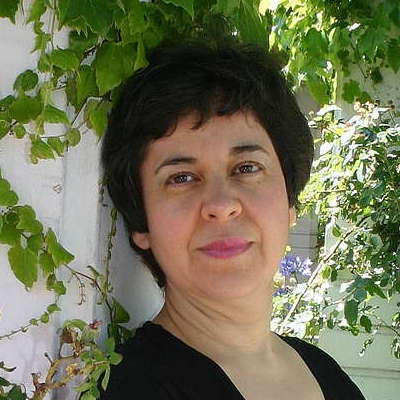 SPONSORED: A Seasoned Champion of New Music. Argentinian-American pianist Mirian Conti in conversation with Andrew Schartmann.
SPONSORED: A Seasoned Champion of New Music. Argentinian-American pianist Mirian Conti in conversation with Andrew Schartmann.
All sponsored features >>
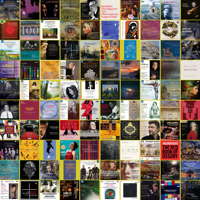 UPDATES: There's a new feature every day at Classical Music Daily. Read about the various ways we can keep in touch with you about what's happening here.
UPDATES: There's a new feature every day at Classical Music Daily. Read about the various ways we can keep in touch with you about what's happening here.
- Didone Abbandonata
- Nicholas Snowman
- Mátyás Seiber
- Yradier
- Vaughan Williams: Serenade to Music
- Beethoven: Triple Concerto
- Tom Lilburn
- Lisa Nardi: The Glory of Spring
In Full Swing
Bellini's 'La Straniera'
at Maggio Musicale Fiorentino,
reviewed by GIUSEPPE PENNISI
A few years ago, the Florence May music festival, one of the oldest in Italy, seemed almost dead as I described on 7 May 2013 - 'Troubles in Florence', Music & Vision. Last year, it seemed 'Born Again' - 14 May 2018, Music & Vision, 14 May 2018. Now, thanks to a new management and an increase in stakeholders' financial support, it appears to be in full swing.
The 2019 program extends from 2 May to 20 June and includes operas, concerts, lectures and events in nearby towns: a real feast for music lovers. In addition, the festival, now at its eighty-third edition, has a theme - Power and Virtue - and goes to its original roots of rediscovering forgotten masterpieces and proposing new works. This is especially clear in its opera section. The inauguration was the Italian premiere of Aribert Reinman's Lear. It includes the rediscovery of Vincenzo Bellini's La Straniera, the world debut of Vittorio Montalti's Le Leggi Fondamentali della Stupidità Umana, the first production in modern times of Intermedi della Pellegrina - a selection of six fully-staged Renaissance intermezzi - as well as - to please less innovative audience members - a new production of Mozart's Le Nozze di Figaro. The concert program is in a similar vein. I will be able to follow only a few performances from this rich and rewarding festival.
On 19 May 2019, I attended a performance of Vincenzo Bellini's La Straniera. Bellini was twenty-six years old when he composed it to a commission from Teatro alla Scala in Milan where his previous opera, Il Pirata, had been a major hit. The opera was an immediate success, even though a few detractors criticized its new style and its restless harmonic shifts into remote keys. Within Italy, it received performances in over fifty cities. Abroad, it was staged in Vienna in 1831, in Paris in 1832, in London in 1832, in New York in 1834, in Lisbon in 1835, and in Madrid in 1850. In the nineteenth century, its last documented performance was in 1875. In the twentieth century, it was first revived in 1953 at La Scala and then in Catania and Palermo. It was presented in concert form at Carnegie Hall. Although it attracted important singers such as Renata Scotto, Montserrat Caballé, Carol Neblett and Renée Fleming, productions were few and far between. Recently, it was revived at the Baden Baden Festival as well as in Catania, Zurich, and Vienna (with Edita Gruberova in the title role). La Straniera is still a little-known opera. There are comparatively few CDs, mostly recorded and distributed by companies with small marketing networks.
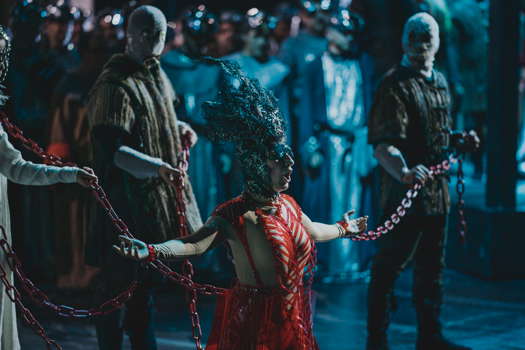
Salome Jicia in the title role of Bellini's La Straniera with chorus members at Maggio Musicale Fiorentino. Photo © 2019 Michele Monasta
There are two reasons for the comparatively modest knowledge of La Staniera: the rather confused and confusing plot, and the quite innovative orchestral and vocal score. At the heart of the libretto there is a complicated series of historical events beginning at the end of the twelfth century as reported in Charles-Victor Prévot d'Arlincourt's 1825 novel L'Étrangère, as well as in dramas drawn from this rather gothic text. It revolves around Agnes, Queen of France, exiled by her husband in Britany, also known as Alaide, the name she has taken in her exile, and La Straniera, 'The Foreign Woman', as she is called by the villagers as well by noblemen in the lake district where she lives. Her brother Baron Valdeburgo looks after her. She ends in love with Arturo, a young man due to be married to Isoletta, daughter of the local Landlord. In misty Brittany, there are all kinds of developments: celebrations of an imminent wedding, stag hunting games, tempests on the lake, trials with jury, duels, until the fatal ending with the death of both Arturo and Agnes/Alaide/La Staniera. Furthermore, Arturo, the tenor is not the romantic young rebel hero, and has a rather paranoid behavior. The solid personality is the baritone, Baron Valdeburgo. This would mix up the syntax and, maybe, even the grammar, of the fledgling romantic melodrama. As a matter of fact, this occurred not by design but because Bellini could not have, as main male singer, Giovanni Battista Rubini, who had triumphed in Il Pirata, because the tenor was fully booked: Thus, he had to make do with a beginner. The tenor has no major aria.
As far as the music is concerned, La Straniera is a rather unusual opera, halfway between neo-classicism and romanticism. It is not a 'bel canto' work. There is only one major bel canto aria by the mezzo, Isoletta, in the second act. The items are mostly duets, trios, quartets and concertato where ariosi spring up. There are germs of Bellini's future opera, such as a tenor-baritone duet which anticipates the well-known 'Squilla la Trompa' in I Puritani. The protagonist's vocal part is quite impervious: she is on stage for almost the entire opera and has to switch from sung declamation through recitative and arioso to arias. Finally, the orchestration is more elaborate than in Bellini's other operas because of the role of the landscape - lake, forests, castles, churches - and of the mist in the plot.
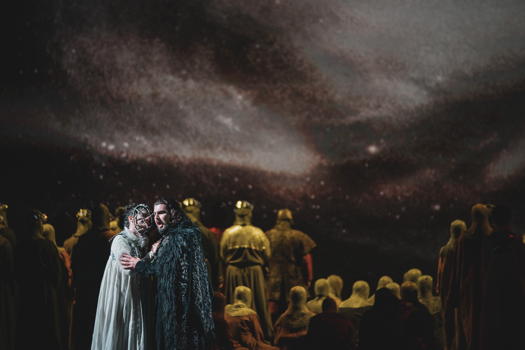
Salome Jicia as the title role and Dario Schmunck as Arturo in Bellini's La Straniera at Maggio Musicale Fiorentino. Photo © 2019 Michele Monasta
Fabio Luisi was in the pit and the Maggio Musicale orchestra is first class. They rendered a gothic atmosphere full of tints and, more importantly, of shading. Luisi led the singers very well too. Under Lorenzo Fratini, the chorus was one of the performance's protagonists.
La Straniera is staged seldom because of the difficulties of finding a soprano who can take up the part. In Florence, Salome Jicia was in the title role. She is a young but already accomplished Georgian singer, who had impressed me in the 2016 Rossini Opera festival in La Donna del Lago - 'An Engrossing Idea', M&V, 10 August 2010. I was even more impressed in this very hard part where she had to marry a complex vocal score with the difficult dramatic ability to make the messy libretto credible.
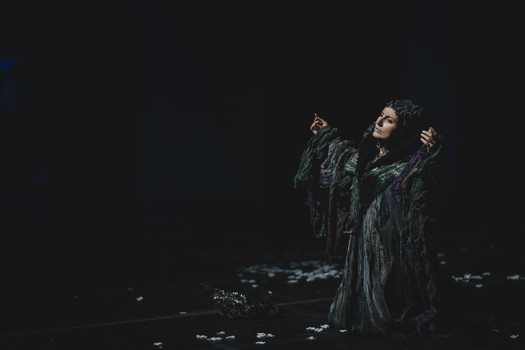
Salome Jicia in the title role of Bellini's La Straniera at Maggio Musicale Fiorentino. Photo © 2019 Michele Monasta
Dario Schmunck has already sung La Straniera in Zurich and Vienna recently and recorded it with 'Opera Rara' in 2007; he knows the part inside out.
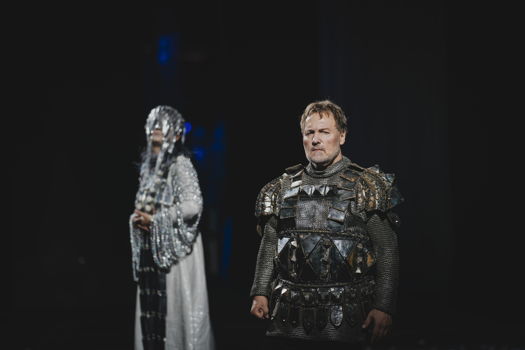
Dario Schmunck as Arturo and Salome Jucia in the title role of Bellini's La Straniera at Maggio Musicale Fiorentino. Photo © 2019 Michele Monasta
Two young singers were very impressive: Laura Verrecchia as Isoletta and Shuxin Li as the Landlord. Serban Vasile was a solid Baron Valdeburgo.
The stage direction (Mateo Zoni) is effective. The sets (Tonino Zera, Renzo Bellanca) are simple and make a great use of projections. The costumes (Daniele Ciprì) are good.
After a few places with open stage applause, there were accolades for all and ovations for Salome Jicia at the end.
Copyright © 21 May 2019
Giuseppe Pennisi,
Rome, Italy



